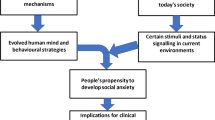Abstract
Experiments are described which assess the behavioral status of two sublines of the Roman High and Low Avoidance strains which have been maintained by brother x sister mating without selection at the Institute of Psychiatry, University of London. The strains demonstrate significant differences in the avoidance behavior for which they were originally selected. However, the Low Avoiding strain did show some high-scoring individuals and a degree of selection pressure was consequently applied to this line. The results of this selection and the performance of these strains in an open field are reported. The data are discussed in the light of a recent report that other sublines no longer display differences in avoidance conditioning.
Similar content being viewed by others
References
Bättig, K., Driscoll, P., Schlatter, J., and Uster, H. J. (1976). Effects of nicotine on the exploratory locomotion patterns of female Roman high-and low-avoidance rats.Pharmacol. Biochem. Behav. 4:435–439.
Bignami, G. (1965). Selection for high rates and low rates of avoidance conditioning in the rat.Animal Behav. 13:221–227.
Broadhurst, P. L., and Bignami, G. (1965). Correlative effects of psychogenetic selection: A study of the Roman high and low avoidance strains of rats.Behav. Res. Ther. 2:273–280.
Coyle, J. T., Wender, P., and Lipsky, A. (1974). Avoidance conditioning in different strains of rat: Neurochemical correlates.Psychopharmacologia 31:25–34.
Driscoll, P., and Bättig, K. (1982). Behavioral, emotional and neurochemical profiles of rats selected for extreme differences in active, two-way avoidance performance. In Lieblich, I. (ed.),Genetics of the Brain, Elesevier/North-Holland, Amsterdam, pp. 95–123.
Durcan, M. J., Fulker, D. W., and Campbell, I. C. (1984). Differences in the stereotypy response but not the hypomotility response to apomorphine in the Roman High and Low Avoiding strains of rats.Psychopharmacology 82:215–220.
Fulker, D. W., Wilcock, J., and Broadhurst, P. L. (1972). Studies in genotype-environment interaction. I. Methodology and preliminary multivariate analysis of a diallel cross of eight strains of rat.Behav. Genet. 2:261–287.
Gentsch, C., Lichtensteiner, M., Driscoll, P., and Freer, H. (1982). Differential hormonal and physiological responses to stress in Roman high-and low-avoidance rats.Physiol. Behav. 28:259–263.
Hewitt, J. K., and Fulker, D. W. (1983). Using the triple test cross to investigate the genetics of behavior in wild populations. II. Escape-avoidance conditioning inRattus norvegicus.Behav. Genet. 13:1–5.
Hewitt, J. K., Fulker, D. W., and Broadhurst, P. L. (1981). Genetics of escape-avoidance conditioning in laboratory and wild populations of rats.Behav. Genet. 11:533–544.
Imada, H. (1972). Emotional reactivity and conditionability in four strains of rats.J. Comp. Physiol. Psychol. 79:474–480.
Martin, J. R., Overstreet, D. H., Driscoll, P., and Bättig, K. (1981). Effects of scopolamine, pilocarpine and oxotremorine on the exploratory behavior of two psychogentically selected lines of rats in a complex maze.Psychopharmacology 72:135–142.
Satinder, K. P. (1971). Genotype-dependant effects of d-amphetamine sulphate and caffeine on escape-avoidance behavior of rats.J. Comp. Physiol. Psychol. 76:359–364.
Satinder, K. P. (1980). Genetically heterogenous and selected lines of rats: Behavioral and reproductive comparison.Behav. Genet. 10:191–200.
van der Staay, F. J., Raaijmakers, W., and Kerbush, S. (1983). Rapid acquisition of two-way active avoidance in inbred Roman Low Avoidance rats.Behav. Genet. 13:435–440.
Wilcock, J., and Fulker, D. W. (1973). Avoidance learning in rats: Genetic evidence for two distinct behavioral processes in the shuttle-box.J. Comp. Physiol. Psyychol. 82:247–253.
Wilcock, J., Fulker, D. W., and Broadhurst, P. L. (1981). Analysis of two-way escapeavoidance conditioning measures from a diallel cross of eight strains of rats.Behav. Genet. 11:339–358.
Author information
Authors and Affiliations
Additional information
This work was supported by Grant RF7038 from the Bethlem/Maudsley Research Fund.
Rights and permissions
About this article
Cite this article
Durcan, M.J., Wraight, K.B. & Fulker, D.W. The current status of two sublines of the Roman High and Low Avoidance strains. Behav Genet 14, 559–569 (1984). https://doi.org/10.1007/BF01068126
Received:
Accepted:
Issue Date:
DOI: https://doi.org/10.1007/BF01068126




